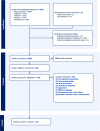Longitudinal changes in skeletal muscle in children undergoing cancer treatment: a systematic review and meta-analysis
- PMID: 40742460
- PMCID: PMC12313780
- DOI: 10.1007/s00431-025-06349-5
Longitudinal changes in skeletal muscle in children undergoing cancer treatment: a systematic review and meta-analysis
Abstract
Skeletal muscle loss during chemotherapy has been associated with poorer outcomes and reduced survival across several types of cancer. However, the extent and progression of muscle loss during treatment for childhood cancers remain unclear. A better understanding could help identify children at increased risk and inform the timing of targeted intervention. This systematic review and meta-analysis aimed to synthesize the evidence on skeletal muscle changes during treatment for childhood cancers and identify factors that influence these outcomes. A systematic search was conducted in CINAHL, Embase, PubMed, SPORTDiscus, and Web of Science. Studies were eligible if they included children and adolescents (< 19 years) undergoing cancer treatment and reported muscle quantity at a minimum of two time points. The methodological quality of the included studies was evaluated using the Newcastle-Ottawa Scale. Twenty studies (n = 646; age range: 2.5-14.7 years) were included. A significant decline in muscle quantity was observed during the early phase of treatment (standardized mean difference (SMD): SMD = - 0.36; 95% CI: - 0.59 to - 0.13; p < 0.05). At later follow-up time points, the overall change was not statistically significant (SMD = - 0.08; 95% CI: - 0.27 to 0.10; p = 0.36). However, estimates of muscle quantity varied significantly by assessment modality (p = 0.048).
Conclusion: Children with cancer experience significant skeletal muscle loss during the intensive phase of treatment. While decrements observed at later time points appear modest, reported outcomes vary considerably depending on the assessment method. Standardized, reliable body composition measures are needed to detect meaningful changes and guide clinical care.
What is known: • Skeletal muscle loss during adult cancer treatment is linked to poor outcomes, yet pediatric data are limited and inconsistent.
What is new: • This is the first systematic review and meta-analysis showing significant early-phase skeletal muscle loss in children undergoing cancer treatment, accompanied by concurrent increases in fat mass. • Considerable variability in skeletal muscle estimates across different body composition assessment methods underscores the need for reliable and sensitive measurement techniques to monitor changes accurately and guide clinical care.
Keywords: Body composition; Childhood cancer; Skeletal muscle; Systematic review and meta-analysis.
© 2025. The Author(s).
Conflict of interest statement
Declarations. Conflict of interest: The authors declare no competing interests.
Figures




References
Publication types
MeSH terms
Substances
LinkOut - more resources
Full Text Sources
Medical

